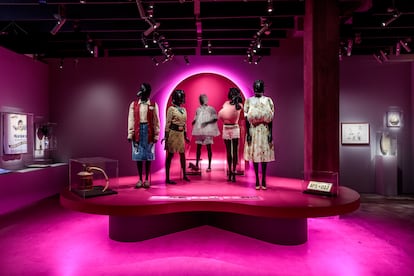The bad taste of John Waters permeates the Academy Museum of Motion Pictures
A new exhibition, open until August 2024, pays homage to the career of the director of ‘Pink Flamingos’ and ‘Polyester’


Pink Flamingos, one of the most tasteless films in American cinema, was born in a clean, neat notebook. The story of drag queen Divine (Harris Glen Milstead), who claims to be the most unpleasant person in the world, is told in blue ink with impeccable calligraphy. The handwritten letters are perfectly laid between the lines of the notebook, respecting the margins and with hardly any crossings-out. This first script for a cult film is a perfect reflection of its author, John Waters, one of cinema’s greatest provocateurs, a sharp dressed gentleman with a neatly trimmed mustache. This week, at the opening of the largest retrospective of his work, Waters greeted the press with the words: “Welcome to the trashcan of my memories.”
The galleries of the Academy Museum of Motion Pictures, in Los Angeles, filled with laughter shortly after Pope of Trash officially opened its doors to the public. The exhibition opened last Sunday and will continue until August 4, 2024, the latest bet of an institution that is still seeking to make a name for itself within the local cultural ecosystem. The museum opened almost two years ago with a major exhibition of Hayao Miyazaki, the Japanese animation genius, which was followed by one about the film noir made between 1898 and 1971. Now it is the turn of the director (and sometimes writer) that has outraged people in the thousands.

A room that recreates a church serves as an entrance to the world of Waters, born in Baltimore in 1946. On the black walls of the gallery, a series of stained-glass windows show images of the muses that have inspired the filmmaker’s work, characters who seek fame even if it comes in the newspaper’s crime section. This mural includes Cinderella, the first film Waters saw in the cinema and which had a great influence on him. This introduction is a nod from the curators, Jenny He and Dara Jaffe, to the early days of his career, which started in 1964 with his first steps as a great provocateur, showing his early short films in a local Episcopal church.
Before the streaming explosion, Hollywood was obsessed with those creators whose vision was powerful enough to bring audiences to movie theaters, and Pope of Trash shows that any trick goes. With the premiere of Pink Flamingos, Waters asked that paper bags be distributed among the audience, in case someone had to vomit. This stunt caused many to flock to the Elgin — the only theater showing it in New York at midnight — looking to put their stomachs to the test.
Thanks to the high demand of the thrill-seeking public, that movie was shown for a year. Its trailer — also part of the exhibition — did not include a single scene; only comments from viewers who had just seen it, such as: “The most disgusting thing I’ve ever seen in my whole life,” “Marvelous,” “Better than Cries and Whispers [the 1972 Ingmar Bergman film].”
This exhibition proves that there is “a sense of humor that knows that we never make our enemies feel stupid. We make them feel smart even when they are not, and get them to laugh, and then we can get them to listen,” Waters said last Thursday in a conversation with the curators. The exhibition also makes you dance, thanks to the creator’s musical obsessions, which are put on display on two films: Hairspray (1988), in which Debbie Harry from Blondie appears, and Cry-Baby (1990), where the filmmaker gave a television star named Johnny Depp one of his first leading roles.
In 1980, the director would use another tactic to satisfy his niche. For Polyester, his first studio film, Waters revived a technology from 20 years earlier. In 1960, the thriller Scent of Mystery, starring Peter Lorre and Elizabeth Taylor, had used something called Smell-O-Vision, a scent spray that accompanied the footage with the promise of a unique sensory experience for the viewer.

Waters adopted that idea to make Odorama. However, instead of delighting the audience with the scent of Elizabeth Taylor’s perfume, as Jack Cardiff’s film did, Waters delivers the smell of disgust by means of a scratch-and-sniff card that the viewers had to bring close to their nostrils in eight scenes. Under the slogan “Smelling is believing,” the filmmaker offered the aroma of farts, gasoline, a skunk, glue and stinky shoes.
Any Simpsons fan worth their salt will not have trouble remembering the episode where Waters lends his voice to John, a gay man who shows the family the value of living the life you want regardless of the opinions of others, to Homer’s discontent. The director refers to these brief appearances or supporting characters a form of “fame maintenance.” And he is not picky: he has appeared in all kinds of diverse contents, from Alvin and the Chipmunks and CSI to horror classics like Seed of Chucky. Appropriately, the exhibition also devotes some space to Waters’ impact on American popular culture.
The Hollywood establishment long resisted the charms of the pontiff of filth. Waters did not enter the directors union until the 1990s, when he was endorsed by David Lynch and Claudia Weill, director of the indie classic Girlfriends (1978). That was a pat on the back for the great rebel of American cinema; a gesture that the author does not stop searching for. Now, John Waters hopes this exhibit helps pave the way for a future star on the Walk of Fame. That would be the ultimate symbol for the king of trash.
Sign up for our weekly newsletter to get more English-language news coverage from EL PAÍS USA Edition
Tu suscripción se está usando en otro dispositivo
¿Quieres añadir otro usuario a tu suscripción?
Si continúas leyendo en este dispositivo, no se podrá leer en el otro.
FlechaTu suscripción se está usando en otro dispositivo y solo puedes acceder a EL PAÍS desde un dispositivo a la vez.
Si quieres compartir tu cuenta, cambia tu suscripción a la modalidad Premium, así podrás añadir otro usuario. Cada uno accederá con su propia cuenta de email, lo que os permitirá personalizar vuestra experiencia en EL PAÍS.
¿Tienes una suscripción de empresa? Accede aquí para contratar más cuentas.
En el caso de no saber quién está usando tu cuenta, te recomendamos cambiar tu contraseña aquí.
Si decides continuar compartiendo tu cuenta, este mensaje se mostrará en tu dispositivo y en el de la otra persona que está usando tu cuenta de forma indefinida, afectando a tu experiencia de lectura. Puedes consultar aquí los términos y condiciones de la suscripción digital.
More information
Archived In
Últimas noticias
Iranian women are also defying the taboo of riding motorcycles (and without a license)
David Bowie, the galactic thinker who encouraged us to break new ground
John Berger and the loss of rural culture
From police officer to bloodthirsty kidnapper: Terror in Mexico during the years of ‘The Ear Chopper’
Most viewed
- David King, chemist: ‘There are scientists studying how to cool the planet; nobody should stop these experiments from happening’
- Reinhard Genzel, Nobel laureate in physics: ‘One-minute videos will never give you the truth’
- Oona Chaplin: ‘I told James Cameron that I was living in a treehouse and starting a permaculture project with a friend’
- Mexico completes its trade shift with the entry into force of tariffs on China and countries without trade agreements
- Sinaloa Cartel war is taking its toll on Los Chapitos










































